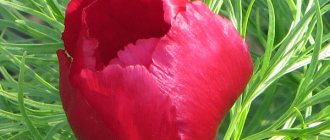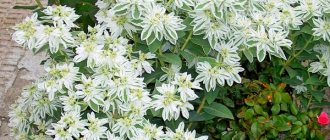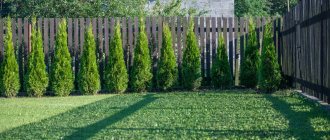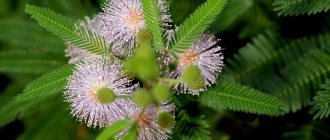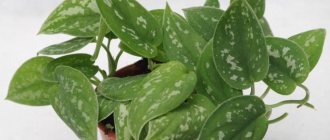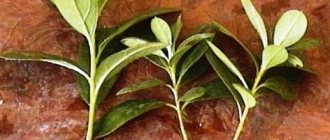Peony angustifolia (Voronets) is an exquisite perennial, which until recently was grown in flower beds only by true admirers of classical plants. In the second half of the last century, this flower was found almost everywhere, but then it was replaced by varietal peonies. Now the fashion for natural gardens is returning, so more and more gardeners are acquiring one or even several bushes of this original plant.
The thin-leaved peony is listed in the Red Book and has the status of a rare species. In its natural habitat, the perennial is protected by law, therefore grazing and construction activities are prohibited in its distribution areas.
Thin-leaved peony: origin story
Peony thin-leaved (narrow-leaved) is the result of the work of breeders. It grows in the Balkan Peninsula, Eastern Europe, Crimea and the Caucasus.
This flower is not like other varieties because it has a large number of small leaves. Externally, the bush resembles a small Christmas tree with a blossoming bud.
Below are the distinctive features of thin-leaved peony:
- bush height no more than 60 cm;
- leaves are trifoliate-pinnate, dissected into linear and filiform;
- a powerful root system on which there are oblong, cone-shaped neoplasms;
- the flowers are large, shades from red to purple, up to 10 buds can be located on one plant at the same time;
- one inflorescence contains up to 200 golden-colored stamens;
- buds are smooth, double or semi-double;
- all flowers open at the same time, and the flowering period is no more than 12 days.
Important. In the store, this type of peony can be sold under the names: Voronets, Azure Flower, Voronok, Red Lazorik.
The flower is considered unpretentious, so some gardeners add it to their flower beds, while others, because of the dense foliage, do not want to see it in their dacha.
Application in landscape design
The narrow-leaved plant is often used in landscape design. It is usually combined with cereals, flax and broom bushes . Looks good on alpine slides.
Narrow-leaved peony will decorate your garden plot
Experienced gardeners recommend planting several types of peonies at the same time . For example, early varieties with late ones. This ensures uninterrupted flowering throughout the season. As soon as one variety fades, another immediately blooms. The angustifolia peony also looks spectacular in artificial slides and stones.
If you follow simple rules for caring for a peony, it will delight you for a long time with its lush inflorescence and pleasant aroma.
Beneficial features
This bush is grown not only for aesthetic purposes. It also has healing properties. The root system of the plant is partially above the ground. It is this that is most beneficial for human health. There are tannins, flavonoids, vitamin C and other elements.
Medicines are made from this type of peony:
- expectorants;
- painkillers;
- bactericidal.
You can also make a medicine from peony yourself. A very popular tincture using the leaf system. It helps fight neuroses.
This flower helps fight various diseases. Even with such as tuberculosis, gout, concussion, cardiovascular diseases, kidney stones and neuropsychiatric diseases.
Important. The plant is considered poisonous, so you need to take the preparation of the tincture and its use seriously, otherwise there is a risk of being poisoned by a poison called neonin, which can cause death.
Popular varieties: photos and descriptions
There are many varieties of this type of peony. They differ in appearance only in the size and color of the buds. The root system and leaves may also differ slightly. You need to be able to distinguish between varieties in order to know which ones are best to grow on your site. The plant is unpretentious, so it feels good in almost any territory of Russia, except for the northern regions.
The main varieties of peony that are grown by gardeners in Russia today are:
- Rubra Plena is a small bush, the height of which does not exceed 50 cm. The flowers are double, bright red. The size of the buds is about 10 cm. Flowering occurs in May. Despite the fact that the peony blooms for only a few days, thanks to its original foliage system, its decorative appeal remains until the end of August.
- The red blue lazorik does not exceed 60 cm in height. The flower is of a non-double type, with golden-colored stamens in the center. Flowering occurs in late May - early June. After this, seed boxes appear in place of the buds. The width of the bush is about 70 cm. It can contain up to 10 buds measuring about 12 cm.
- The thin-leaved terry peony has a small size (up to 60 cm in height) and a well-developed root system. Its leaves are thread-like, and one bush contains 6-12 buds, which bloom at the same time. Colors can range from bright to soft red. The flowers bloom in early June and last for about 12 days. Inside the buds there are a large number of petal-shaped stamens.
general information
The narrow-leaved peony is a perennial plant distinguished by surprisingly beautiful leaves and remarkable red flowers. Unfortunately, this plant is rarely found in nature today, so it is listed in the Red Book. But narrow-leaved peony today can be increasingly seen in gardens. For a long time, the flower grew only in the areas of ardent adherents of the classics, but over time everything changed somewhat.
The description of the thin-leaved peony deserves special attention. The height of an adult shrub varies from 40 to 65 cm. The diameter of the buds on them is about 8−11 cm. They bloom at the same time. It is for this reason that Voronets during the flowering period look like very lush and beautiful bouquets.
Voronets remains attractive even after flowering: its thin leaves, reminiscent of a fern in appearance, look very pretty.
Growing and caring for narrow-leaved plant varieties
Thin-leaved peonies are unpretentious, so they do not require special care. After planting in open ground, they must be periodically weeded, watered and fed. Proper agricultural practices are important for healthy crop growth.
Important. Mulching the soil is mandatory for this type of peonies.
Watering
If the weather is dry outside, the flower needs to be watered every other day. If it rains - 1-2 times a week. Moistening is needed only when the soil dries to a depth of 2-3 cm.
Basic rules of watering:
- It is advisable to use up to 30 liters of water per bush;
- watering is carried out at the root;
- It is forbidden to water plants in wet weather, as this leads to rot of the root system;
- After moistening the soil, be sure to remove weeds and loosen the soil.
Top dressing
Another important point is the application of fertilizers for the rapid development of the flower. Without nutrients, the first flowering will occur only 4-5 years after planting.
Peonies should be planted in the fall. At the same time, it is recommended to carry out the first fertilizing with phosphorus and potassium: 0.05 - 0.06 kg of fertilizer per bush.
Important. It is prohibited to use nitrogen as a fertilizer. Excessive amounts of it in the soil will cause the plant stems to droop and there will be no more than five buds. There is also a risk of infection with pathological fungi. It is not recommended to use organic fertilizers.
How to fertilize:
- The first complementary feeding should be done after planting the plant.
- When the snow melts, the soil must be disinfected to eliminate the possibility of plant diseases.
- 3-5 days after treating the soil, potassium-phosphorus fertilizers are applied. The procedure must be repeated every 12-16 days until flowering ends.
- Fertilizers are applied only in liquid form. They should be administered under the root in the morning or evening. This will prevent the plant from getting burned by the scorching sun.
These simple rules will help you grow beautiful flowers that will decorate any garden plot.
Propagation of needle bushes
You can obtain planting material in two ways:
- Seminal. The collection of material is carried out after the end of flowering. They are carefully collected, disinfected, dried and placed in a paper bag to prevent them from suffocating. You can also immediately plant the seeds in a pot, which is placed in a cool, dark place. It is important that the soil is constantly moist so that seedlings do not appear above ground. Planting in open ground should be done in the spring along with a pot. In the fall you need to replant by removing the pot.
- Dividing the bush. In this case, it is necessary that there are buds on both parts of the root. The knife must be treated in an alcohol-containing solution. After division, the cut site is treated with activated carbon. Next, the peony is planted.
Important. You can get a flowering bush using the seed method only after 3-4 years. If the division method is used, then within a year the first buds may appear.
Reproduction methods
Most often, thin-leaved peony is planted using bush propagation. To do this, I use mature bushes that are about 5 years old; this method is less time-consuming and labor-intensive and helps rejuvenate the plant.
This is usually done in the fall. The plant is divided into parts (divisions) with 2-3 buds, and planted in a hole measuring 60x80 cm, with nutritious soil previously poured into it; during this period, you can also change its place of growth. The bushes are planted at a distance of a little more than half a meter from each other, sprinkling the buds with soil so that there is about 5 cm of soil above the buds, and be sure to sprinkle the cut areas with wood ash to avoid rotting. To top it all off, you need to pour a small hill around the seedlings and fertilize them with humus or peat. But you should not compact the soil at the planting site; the fragile roots of the plant suffer greatly from this.
Another, but no less popular, planting method is sowing seeds. It is more labor-intensive and time-consuming, and the most unpleasant thing about this method is that there is a high probability that the sown seeds may not sprout.
The seed pods are collected in July, when they have not yet opened, wrapped in paper and hidden in the refrigerator until mid-autumn. Almost before winter they are sown in loosened soil, and the plant will sprout with the arrival of spring. But thin-leaved peony is rarely propagated in this way, mainly solely due to the fact that in this case, at least five, or even six years will pass before the first flowering.
The photo shows a seed pod of a thin-leaved peony
There is also a rarer method of propagation - by root cuttings and is also performed in the fall, since at this time the roots of the plant are formed. Vertical root layers are planted at a distance of 60-70 cm.
Diseases and pests
Thin-leaved peony is susceptible to certain types of diseases:
- Gray rot. It appears on the foliage system of the plant from an excess of moisture - excessive watering or prolonged rains. It is easily noticeable, and you can get rid of it by treating the bush with fungicides. If the rot has affected a large part, then it is better to remove it and treat the rest of the bush. This will speed up the healing process.
- Rot also appears on the root as a result of abundant watering. It becomes soft. Outwardly, this is manifested by blackening of the stem and wilting of the plant. If, upon inspection of the plant, no signs of disease are noticeable, then the problem is at the root. The flower needs to be dug up and examined. The affected areas are removed, and the cut site is treated with activated carbon. The soil also needs to be disinfected. After this, the plant can be planted in the same hole or dug another one.
The plant has a strong immune system, so diseases rarely affect it. Much more often you can encounter the following pests:
- aphid;
- bronze;
- turf ant;
- caterpillars.
Modern industrial poisons help get rid of them.
Important. Beetles in small numbers do not harm peonies. Therefore, you should not immediately use the poison. Exposure to poisons will negatively impact vitality. However, with a large number of beetles, treatment is inevitable.
Choosing a landing site
If several conditions are met, even an inexperienced gardener will be able to not only grow, but also maintain the life of the plant for a long time.
The soil should not be soggy so that the rhizomes do not rot. The exception is the period of bud formation; at this time the plant should be watered abundantly. It is important that the soil is not acidic; thin-leaved peony will not take root in such an environment. To do this, the soil must be alkalized with mineral fertilizers, or lime, or wood ash. A 10-15 cm layer of drainage, for example, small stones, gravel, broken bricks, should be placed in the hole of the planting pit. The thin-leaved peony loves moisture, but suffers and quickly dies from stagnation of moisture at the roots.
Peony thin-leaved should be planted in a well-lit area; it feels great in the shade, but it is still worth spending most of the time in the sun. The planting site should be protected from drafts and strong winds; the plant should not be planted in an open area, but perhaps in a corner of the garden. From an aesthetic point of view, when choosing a place for future planting of thin-leaved peony, it is worth observing the temporary characteristics of flowering. After all, in the middle of summer, the aesthetic appearance of the plant’s leaves will fade away, and perhaps it’s worth hiding it by planting it in flowerbeds behind or among lushly flowering fellow plants for the second half of summer and early autumn.
